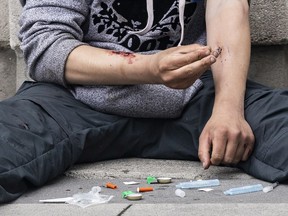Street drugs may be cut or mixed with other dangerous substances

Article content
Drug poisonings appear to be on the rise in the Sudbury area, the Community Drug Strategy said on Monday
Advertisement 2
Article content
In addition, there have been more “unexpected reactions” from the use of substances in the region, the group said in a release.
Article content
“While we cannot confirm the substance(s) causing the overdoses, this situation serves as an important reminder to the community that street drugs may be cut or mixed with substances such as benzos (benzodiazepines), xylazine, fentanyl, or carfentanil,” the Community Drug Strategy cautioned.
“Frontline workers warn that more toxic substances than usual may be circulating locally and that multiple naloxone kits have been required to reduce overdoses.”
An overdose occurs when a person uses a substance,and their body is unable to handle the effects. As a result, the brain is unable to control basic life functions. The person might pass out, stop breathing, or experience a seizure. Overdoses can be fatal and non-fatal.
Advertisement 3
Article content
To prevent overdoses:
– Avoid mixing drugs, including prescribed, over-the-counter, and illegal drugs.
– Avoid drinking alcohol while using other drugs.
– Use caution when switching substances: start with a lower dose than usual.
– If you have not used in a while, start with a lower dose. Your tolerance may be lower.
When using substances, consider:
– Having a trusted person with you who can provide support as needed.
– Visiting an overdose prevention site such as The Spot in Greater Sudbury (Réseau ACCESS Network).
– Connecting with the National Overdose Response Service at 1-888-688-677 (NORS line).
– Accessing the Brave App.
– Not using drugs when you are alone.
– Drug checking is available at The Spot in Greater Sudbury (Réseau ACCESS Network), even if you are not using substances at the site. Carry multiple naloxone kits. Know how to use them.
Advertisement 4
Article content
– Calling 911 if you suspect an overdose.
Opioid overdose symptoms include fingernails and lips turning blue or purplish black; skin turning bluish purple, grayish, or ashen, depending on skin tone; dizziness and confusion; and the person can’t be woken up.
Other symptoms include choking, gurgling, or snoring sounds; slow, weak, or no breathing; and drowsiness or difficulty staying awake.
Due to benzodiazepines (benzos) toxicity, an overdose may last for hours and look like extreme sleepiness or passing out; poor balance and movement control; slurred speech; and blackouts and memory loss.
If a person is overdosing, give them Naloxone, which will help reverse an opioid overdose and do no harm if the overdose is not due to opioids. This may improve breathing, but the person may not regain consciousness due to sedation. Additional doses may be needed.
Also, call 911 to get medical help and keep monitoring breathing. Stay with the person until help arrives. If the person is unconscious, place them in the recovery position.
For a free naloxone kit, contact The Point at Public Health Sudbury and Districts, Réseau Access Network, Sudbury Action Centre for Youth (SACY), or ask your local hospital or pharmacy.
Or, visit www.ontario.ca/page/get-naloxone-kits-free.
Twitter: @SudburyStar
Article content
Sudbury group warns drug poisonings may be on the rise - The Sudbury Star
Read More

Comments
Postmedia is committed to maintaining a lively but civil forum for discussion and encourage all readers to share their views on our articles. Comments may take up to an hour for moderation before appearing on the site. We ask you to keep your comments relevant and respectful. We have enabled email notifications—you will now receive an email if you receive a reply to your comment, there is an update to a comment thread you follow or if a user you follow comments. Visit our Community Guidelines for more information and details on how to adjust your email settings.
Join the Conversation